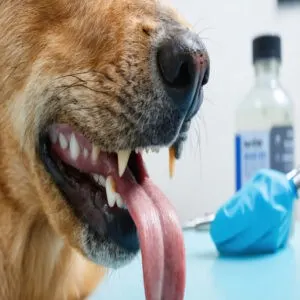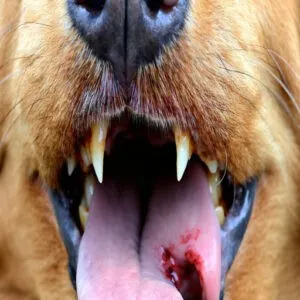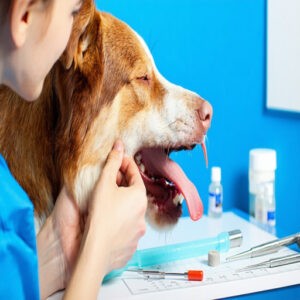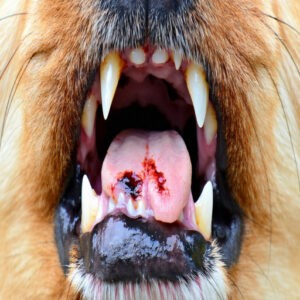This site is supported by our readers. We may earn a commission, at no cost to you, if you purchase through links.

Reasons range from decay or unerupted teeth to orthodontic concerns like crowding.
The process involves anesthesia and careful monitoring, with recovery requiring soft foods, pain management, and watchful care for signs of infection.
Costs can vary but typically fall between $50-$200 per tooth.
Maintaining oral health with regular brushing and dental chews can help prevent extractions altogether.
Curious about keeping your dog’s smile healthy? Let’s explore prevention and aftercare tips.
Table Of Contents
- Key Takeaways
- Dog Tooth Extraction Reasons
- Extraction Procedure Overview
- Preparation and Recovery
- Potential Complications
- Cost and Aftercare
- Frequently Asked Questions (FAQs)
- What happens if a dog has a tooth extraction?
- Why does my dog need a dental extraction?
- How do you extract a dog tooth?
- What should a dog do if he has a tooth extraction?
- How much does a dog tooth extraction cost?
- When should a dog get a tooth extracted?
- How long does it take for a dog to recover from tooth extractions?
- How much does a tooth extraction for a dog cost?
- Are tooth extractions painful for dogs?
- Are dogs happier after tooth extraction?
- Conclusion
Key Takeaways
- Keep a close eye on your dog’s oral health to prevent issues like periodontal disease, fractured teeth, and infections that might require extractions.
- If your dog undergoes a tooth extraction, be ready with soft foods, follow your vet’s pain management plan, and monitor the healing site closely.
- Budget for the costs, which typically range from $500 to $1,250, including anesthesia, X-rays, and medications, but explore pet insurance or financing options to ease expenses.
- Regular brushing, dental chews, and vet checkups can prevent tooth problems and costly extractions, helping your dog stay healthier and happier.
Dog Tooth Extraction Reasons
If your dog needs a tooth extraction, you’ll want to understand the common causes, which include periodontal disease, fractured teeth, and problems with tooth alignment.
Your veterinarian might recommend removing one or more teeth if they spot issues like exposed tooth pulp, severe decay, or teeth that didn’t fall out naturally during puppyhood.
Periodontal Disease
A silent enemy lurks in your dog’s mouth – periodontal disease affects nearly 90% of dogs by age two.
This common dental disease starts with plaque buildup and gum inflammation, leading to bacterial infections and tooth decay.
If left untreated, gingivitis causes can escalate to severe gum disease, dental abscesses, and tooth infection, making extraction necessary.
Understanding dog periodontal disease is important for prevention and early detection, to catch dental disease early by watching for signs like bad breath and swollen gums.
Fractured Teeth
Your dog’s playful nature can lead to tooth fractures from chewing hard objects or accidental trauma.
If you notice broken enamel, cracked molars, or tooth shards, don’t wait to see your vet.
Dental trauma often exposes the sensitive pulp inside, causing pain and risking infection.
Even small breaks in your pup’s teeth can worsen over time, making extraction necessary to prevent complications.
Tooth Decay
Like a broken tooth, tooth decay spells trouble for your furry friend.
Dental caries and tooth erosion often lead to painful infections that require dog tooth extraction.
Plaque formation triggers a cascade of problems:
- Enamel loss exposes sensitive tooth layers
- Bacteria multiply, causing tooth abscess
- Gum disease spreads to nearby teeth
- Infection can travel through the bloodstream
When caught early, your vet can treat minor decay, but severe cases need extraction to protect your dog’s health.
Unerupted Teeth
Problems with tooth impaction often start early in a dog’s life.
Unerupted teeth affect jaw alignment and can develop dangerous cysts, particularly in the mandibular first premolar and canine teeth.
Dental crowding and genetics play key roles, making some breeds more susceptible to retained deciduous teeth.
A veterinary dental webpage explains the causes, diagnosis, and treatment of these dental issues.
When discovered, oral surgery and teeth removal become necessary, especially if the dog’s over one year old.
Oral Tumors
Oral tumors in dogs can appear as black or flesh-colored masses, often accompanied by bad breath and excessive drooling.
If you notice mouth sores or tooth lesions alongside difficulty eating, your vet might recommend dog tooth extraction as part of the treatment plan.
Common types include melanoma, squamous cell carcinoma, and fibrosarcoma, which may require dog oral surgery to prevent the spread of oral cancer and maintain your pet’s dental health.
Orthodontic Abnormalities
When your dog’s teeth don’t align properly, it can lead to serious bite problems.
Orthodontic abnormalities, like dental crowding or malocclusion, often require tooth extraction to prevent damage to the surrounding tissue.
Retained deciduous teeth that don’t fall out naturally can force permanent teeth into awkward positions.
Your vet might recommend canine tooth extraction or orthodontic surgery if jaw issues are causing your pup discomfort or making it hard to eat.
Extraction Procedure Overview
A dog tooth extraction procedure requires precision and specialized surgical tools to guarantee your furry friend’s comfort and safety.
Your veterinarian will first administer general anesthesia, followed by detailed dental X-rays to map out the affected teeth and surrounding structures.
Regular dental care is essential, and more information can be found in this helpful guide.
The canine dental extraction process typically takes 30-60 minutes per tooth, depending on its location and condition.
Here’s what happens during your dog’s dental surgery:
- The vet carefully separates the gum tissue from the tooth using specialized instruments, exposing the tooth root and bone
- Through specific extraction methods, they’ll gently loosen the tooth from its socket while preserving the surrounding bone
- Once removed, they’ll clean the socket and close the site with dissolvable stitches
Understanding anesthesia risks and monitoring protocols helps secure a smooth tooth extraction procedure for your pup.
Preparation and Recovery
You’ll need to prepare your home and schedule before your dog’s tooth extraction, just as you’d get ready for your own dental procedure.
After the surgery, you’ll help your furry friend recover with soft foods, pain medication, and careful monitoring for about two weeks, ensuring they stay comfortable and heal properly.
Pre-Surgery Instructions
Most veterinarians require your dog to fast for 8-12 hours before dog dental surgery to prevent anesthesia risks.
For pre-surgery prep, schedule a physical exam and dental X-rays to assess your pet’s health.
You’ll need to stop food after midnight, but small amounts of water are typically allowed until morning, and remember to follow your vet’s medication guidance about continuing or stopping any current prescriptions, especially regarding anesthesia risks.
Post-Surgery Care
Your furry friend will need extra TLC during dog tooth extraction recovery.
Keep them confined and calm for the first 24 hours, limiting activity to prevent wound healing complications.
For ongoing care, prioritize dog dental care to maintain their oral health.
Monitor the extraction site for swelling or bleeding, and follow your vet’s pain relief protocol strictly.
Rest periods are essential – no rough play or chewing toys.
Schedule follow-ups to confirm proper healing and address any postop dog dental concerns.
Soft Food Recommendations
After the procedure, feeding mushy meals keeps your dog comfortable during dog tooth extraction healing.
Stick to wet diets like soaked kibble, canned food, or pureed foods for about a week.
Easy eats include tiny pieces of boiled chicken, soft pasta, or cream cheese.
For gentle bites during dog tooth extraction recovery, you can hand-feed small "meatballs" of canned food, especially if the extractions were near the front.
The soft food options can be particularly beneficial in reducing discomfort and promoting healing in your dog’s dental health.
Pain Management
Managing dog tooth pain requires a multi-layered approach to comfort measures and pain relief.
Modern pain management combines local anesthetics with targeted medication options to keep your pup comfortable throughout recovery.
Understanding tooth extraction pain is essential for effective management.
- Local anesthetic blocks directly target nerve endings for immediate dental pain control
- Anti-inflammatory medications reduce swelling and provide ongoing relief
- Cold therapy and specialized nursing care support healing during recovery
Monitoring for Complications
While your dog heals from the tooth extraction, keep a close eye on swelling signs and pain levels.
Normal signs include mild swelling and slight drooling for 2-3 days, but if you notice excessive bleeding, severe pain, or infection control issues like pus or strong odor, contact your vet right away.
Track the healing process through regular follow-ups to catch any dog dental complications early.
Potential Complications
While most dog tooth extractions heal smoothly, you’ll need to watch for signs of complications like infection, swelling, or excessive bleeding in the days following surgery.
You should contact your vet immediately if you notice your dog showing unusual symptoms such as persistent bad breath, difficulty eating, or increased drooling after the typical recovery period, which may indicate infection.
Infection Signs
After dog tooth extraction, keeping an eagle eye out for infection signs can save your pup from serious complications.
A dog tooth abscess or dental infection isn’t something to ignore. Watch for these red flags: Recognizing sick dog signs is essential in the post-extraction period to prevent further health issues.
- Bright red, swollen gums that seem tender when touched
- Unusually bad breath combined with yellowish pus formation around the extraction site
- Fever symptoms like lethargy and loss of appetite, especially with redness signs
Antibiotic Treatment
Your vet will prescribe antibiotics based on dosage guidelines that fight bacterial infections while minimizing antibiotic resistance.
Treatment duration typically spans 7-10 days following dog tooth extraction, with medications given at specific times.
You’ll need to follow the prescribed schedule carefully to prevent dog tooth infection and oral complications, and keep an eye out for medication side effects like digestive upset.
Urgent Veterinary Care
When you spot signs of trouble following a dog tooth extraction, don’t wait around – head straight to emergency care.
If your pet shows excessive bleeding, severe swelling, or intense pain despite medication, these could signal critical complications requiring urgent veterinary attention.
For after-hours emergencies, keep your emergency vet’s number handy, and remember that quick action during complications can make all the difference, which is why acting fast is crucial for urgent veterinary attention.
Prevention and Good Oral Hygiene
Several dog dental care options, including dental wipes, powders, and water additives, help maintain oral health between brushings.
You’ll find success by combining regular brushing techniques with healthy chews and dental diets. Fresh water should always be available to help naturally clean teeth.
Using dog dental products can be an effective way to reduce plaque and tartar buildup.
- Try making tooth brushing a bonding experience – sing a silly song while you brush
- Keep dental treats in different spots for surprise rewards
- Create a "spa day" routine that includes gentle gum massage
Cost and Aftercare
You’ll need to budget between $500 and $1,250 for your dog’s tooth extraction, which includes the procedure, X-rays, and necessary aftercare medications.
After the surgery, you’ll need to follow specific care instructions for 10-14 days, including serving soft food and monitoring the extraction site while your furry friend heals.
Factors Affecting Cost
Five key elements shape your dog tooth extraction cost.
Location fees vary substantially between urban and rural clinics, while surgical time depends on the complexity of the procedure.
Your pet’s size affects anesthesia costs, as larger dogs need more medication.
Clinic rates differ based on the veterinarian’s experience and facility type.
Insurance premiums and pre-existing conditions can influence your out-of-pocket expenses.
Average Cost of Extraction
The average cost of dog tooth extraction varies across regions, with basic extraction fees ranging from $50-$200 per tooth.
Your veterinary bills will include surgical costs for anesthesia ($190-$250), dental X-rays ($75-$120), and additional dental expenses like pain medication ($35-$50).
On the West Coast, you’ll pay around $35 per tooth, while East Coast canine tooth extraction costs typically reach $1,150 for complete procedures with X-rays.
Insurance Coverage
Leading pet insurance providers now offer thorough coverage for dog dental extractions.
You’ll find various pet plans that can substantially reduce dog dental costs when you meet specific requirements.
Most policies cover both accident-related and illness-based extractions, with coverage limits varying by provider.
- ASPCA’s Complete Coverage handles both accident and illness-related extractions
- Trupanion covers dental procedures with annual exam requirements
- Pets Best provides extensive coverage including periodontal disease treatment
Financing Options
When pet insurance doesn’t cover all your dog dental costs, several financing options can help manage the expense of tooth extraction.
CareCredit and Scratchpay offer flexible payment plans with varying terms.
Here’s what you’ll find with today’s most popular financial assistance programs:
| Payment Option | Features |
|---|---|
| CareCredit | Flexible healthcare credit card, interest-free promotions |
| Scratchpay | Higher approval rates, 0% options available |
| Veterinary Payment Plans | In-house financing through clinics |
| Medical Credit Cards | Specific for pet healthcare expenses |
| Wellness Plans | Monthly payments for routine care |
These programs, including Wellness Plans and Veterinary Payment Plans, provide a range of options for managing pet healthcare expenses, making it easier to afford flexible payment plans and necessary treatments like tooth extraction.
Follow-Up Appointments
Don’t skip follow-up appointments—they’re key to checking your dog’s healing progress.
These exams help your vet spot potential issues early and guarantee the dog tooth extraction healing time stays on track.
Regular puppy grooming appointments can also contribute to the overall health and wellbeing of your dog, making them more resilient to recovery from procedures like tooth extraction.
Post extraction care includes monitoring for infections or missed root tips.
Schedule veterinary checkups promptly, as proper dog after tooth extraction treatment makes all the difference in their recovery.
Frequently Asked Questions (FAQs)
What happens if a dog has a tooth extraction?
Imagine this: your dog wakes up groggy but already on the mend.
After tooth extraction, they’ll need soft foods, rest, and plenty of TLC.
Pain meds, vet check-ins, and patience guarantee a smooth recovery.
Why does my dog need a dental extraction?
Your dog might need a dental extraction due to advanced dental disease, broken teeth, or issues like overcrowding, oral tumors, or infections.
Removing problematic teeth prevents pain, infections, and serious complications affecting their overall health.
How do you extract a dog tooth?
Veterinarians extract dog teeth under anesthesia, using X-rays to guide them.
They loosen the tooth with specialized tools, remove it carefully, and close the site with sutures to promote healing, ensuring your dog’s comfort and safety.
What should a dog do if he has a tooth extraction?
Keep your dog calm and relaxed after a tooth extraction.
Stick to soft foods, avoid chew toys, and limit rough play for 10-14 days.
Watch for signs of infection, and follow up as needed.
How much does a dog tooth extraction cost?
Dog tooth extraction costs range from $40 to $350 per tooth, depending on complexity.
Add anesthesia, X-rays, and cleaning, and the total can climb to $500-$
Pet insurance or financing options might help manage expenses.
When should a dog get a tooth extracted?
You’ll need to evaluate an extraction if your dog’s tooth is fractured, infected, causing pain, crowding others, or linked to oral tumors.
Ignoring it can worsen health issues, so check with your vet promptly.
How long does it take for a dog to recover from tooth extractions?
Healing’s a journey, not a sprint.
Most dogs bounce back within a week or two after tooth extractions.
Stick to soft food, restrict play, and give prescribed meds to guarantee they’re comfy and healing smoothly.
How much does a tooth extraction for a dog cost?
Dog tooth extraction costs depend on factors like location, clinic, and tooth count.
A dental cleaning with anesthesia often ranges $500-$900, while extractions cost $40-$350 per tooth.
Pet insurance or financing options can ease expenses.
Are tooth extractions painful for dogs?
Nearly 90% of dogs over three develop dental disease, and untreated issues can cause pain.
Tooth extractions themselves aren’t painful thanks to anesthesia, but recovery can be uncomfortable.
Pain meds and careful care guarantee comfort afterward.
Are dogs happier after tooth extraction?
Your dog likely feels much better after a tooth extraction.
Removing problem teeth relieves pain and discomfort, letting them eat, play, and enjoy life more.
You might notice a happier, healthier pup once they’ve healed!
Conclusion
Think of your dog’s dental health like the foundation of a house – neglect can lead to cracks and costly repairs.
Whether it’s addressing pain from a fractured tooth or tackling periodontal disease, dog tooth extraction is sometimes the only solution to guarantee their comfort and well-being.
Stay proactive with regular cleanings, dental chews, and vet checkups to avoid future extractions.
When surgery is necessary, proper recovery care makes all the difference.
Your pup’s smile deserves it!
- https://www.petmd.com/dog/procedure/dog-tooth-extraction
- https://www.whitehousevet.com/site/blog/2024/02/15/dog-tooth-extraction
- https://www.spinnakervetclinic.com/site/blog/2023/11/15/removing-dog-teeth
- https://www.nevccc.com/site/blog/2023/03/30/dog-tooth-extraction
- https://vdsvets.com/tooth-extractions/














